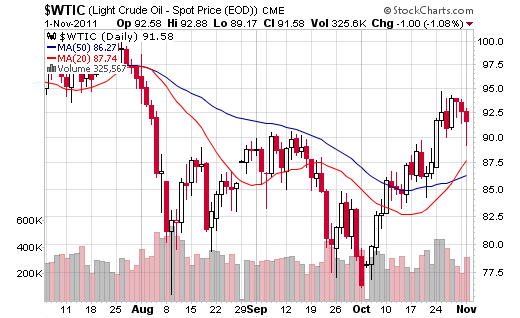As you know, I’m a firm believer that oil prices are among the best
indicators for the stock market. When oil prices rise, stocks do too. It’s
because they both react to the same catalyst: expectations about future
growth.
Over the last few days, I’ve advised readers to watch the $90 a barrel
level for oil. A break below $90 is a sign that investors are worried about
future growth.
We saw this clearly in late summer. Oil began its decline after the
disastrous Durable Goods report from July 28.

The inability to break above $90 in September was a good indicator that new
lows were coming. And sure enough, as the talk of a double-dip recession
reached a crescendo, oil was trading down into the upper-$70s.
Yesterday, after the semi-positive employment news, oil pushed higher as
investors anticipated steady growth at the very least.
More telling to me, though, was the recovery from sub-$90 on Tuesday. That
show of strength was not reflected in the stock market. In fact, the
S&P 500 closed at its lows of the day.
Why did oil move higher? Couldn’t we just get a read on the stock market?
Or use gold as an indicator?
Oil is more useful as an indicator than even stocks because of one thing:
business. Many businesses use oil futures to hedge their operating costs
and lock in supply. Airlines and shipping/trucking, for instance, are
better economic indicators than Apple (Nasdaq:AAPL).
Stocks, along with gold, are far too dependent on the whims of investors to
be a reliable indicator.
Right now, oil looks more bearish than bullish. And how it reacts to
Friday’s Nonfarm payroll number could set the stage for the next big move
for stocks.
The Fed’s latest FOMC meeting yielded no changes to the statement.
“Significant downside risks” remain, though growth has improved.
Of course, what exactly the Fed means by “significant risks” isn’t spelled
out. We can assume Europe, or the high unemployment rate. But I’d say it’s
a rhetorical statement that allows the Fed to keep Operation Twist going
and leaves the threat of QE3 on the table.
Why do I call QE3 a threat? Because like it or not, the Fed sees the stock
market as part of the key to economic recovery. If it can maintain some
underlying strength in stocks by keeping shorts at bay with the threat of a
liquidity-driven rally, it will.
A majority of economists believe that QE3 is coming at some point next
year. I’m not so sure. The Fed can accomplish a lot just by keeping QE3 on
the table. Of course, if growth takes a nosedive, or interest rates move
higher, the Fed will act.
But those are the only scenarios (outside of some economic shock) I see
that will prompt the Fed. And because I believe the economy will stumble
along, I don’t think the Fed acts.
Write me anytime at [email protected]
Ian Wyatt
Editor
Daily Profit
 Facebook
Facebook
 Twitter
Twitter